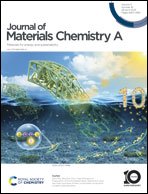Tuning proton kinetics in BaCo0.4Fe0.4Zr0.2–XYXO3–δ triple ionic-electronic conductors via aliovalent substitution†
Abstract
The BaCo0.4Fe0.4Zr0.1Y0.1O3−δ (BCFZY0.1) triple ionic-electronic conductor (TIEC) has received thorough investigation as a potential cathode in protonic ceramic fuel cells (PCFCs) due to its excellent oxygen reduction reaction and concurrent conduction of electrons, oxygen ions, and protons. Proton conductivity and surface reactivity are paramount in PCFC cathodes to improve the active reaction area. However, few instances of direct proton kinetic measurements have been reported. In this work, a suite of BaCo0.4Fe0.4Zr0.2−XYXO3−δ (X = 0, 0.1, 0.2) materials is synthesized and evaluated through hydrogen permeation and electrical conductivity relaxation measurements to investigate the effect of aliovalent substitution of Y3+ for Zr4+ on bulk proton conductivity and surface kinetics. The permeation results suggest that aliovalent substitution significantly improves the proton conductivity upon a 10% B-site doping of Y, while further incorporation of Y slightly decreases conductivity from the 10% optimum. Through three separate conductivity relaxation measurements, oxidation, hydration, and isotopic switching, an improvement in the proton kinetics with Y-doping is observed in humidified oxidizing conditions, emulating conditions in intermediate-temperature electrochemical devices. These observations suggest that aliovalient doping plays an important role in the incorporation and mobility of protons in TIEC materials.

- This article is part of the themed collection: #MyFirstJMCA


 Please wait while we load your content...
Please wait while we load your content...